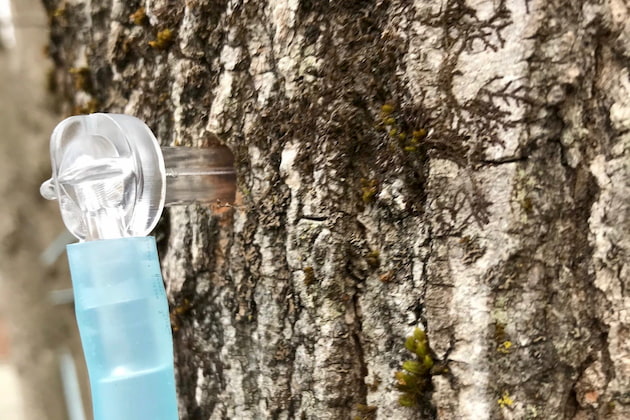UVM Proctor Page
Tapholes – Straight or Slanted? The sap doesn't care
Researchers study spout angle and affect on sap flow
By T.D. PERKINS AND W.T. BOSLEY, UNIVERSITY OF VERMONT PROCTOR MAPLE RESEARCH CENTER | JUNE 10, 2020
UNDERHILL CTR., Vt.—Straight or slanted? The sap doesn’t care the angle of your spout.
Historically it was recommended that tapholes be drilled at a slight angle to allow sap to run out to reduce freeze heaving of spouts and to reduce sap souring in the taphole.
Starting shortly after the introduction of the “small” spout (19/64”, 5/16”), maple equipment manufacturers started to recommend that tapholes be drilled straight in.
The most common reason for this was stated that it avoided the creation of oval tapholes.
Geometrically, as long as care is taken to adopt a stable position and steady hand on the drill, it is not possible to create an oval taphole with a round tapping bit.
Rather, it is poor technique (bad footing, working too quickly, drilling with one hand, tapping too far overhead, or not fulling removing the bit from the taphole before moving the drill) that causes movement of the drill and bit.
Drill and bit movement during drilling a taphole is what results in oval tapholes.
Regardless of the cause, oval tapholes should be avoided as they can cause microleaks, weeping tapholes, and reduced sap yield.
The question still remains however, is there any difference in sap yield when tapping at a slight angle (the historical recommendation) or tapping straight in (the current recommendation)?
In the spring of 2020, we tapped all trees on three mainlines by drilling straight in.
Three other mainlines in the same area were tapped by drilling at a slight (~10°) angle upward towards into the tree.
The same spouts (Leader Evaporator Clear Polycarbonate one-piece Check-valve spouts) were used throughout, and all tapping was done by the same person over the span of two days.
Taphole depth was set to 2” with a bit-stop in all cases.
This was not modified in the slant treatment to account for the minor reduction in taphole depth due to tapping angle.
Each mainline was connected to an individual mini-releaser which incremented a counter every time the releaser dumped. All releasers utilized a common vacuum system operating at 25” Hg.
Releasers were calibrated near the end of the 2020 sap flow season so the volume of sap released from each could be established.
A tally was made of the number of dumps made for each releaser daily throughout the season.
The seasonal total count was multiplied by the calibration factor for each individual releaser to determine total sap volume for each mainline and divided by the number of taps on the mainline to arrive at a total sap yield (gallons of sap per tap).
Sugar content measured during the season was used to calculate syrup yield for each mainline.
The three replicate mainlines for each treatment were averaged.
Total syrup yield for the two treatments is shown in Figure 1.
There was no difference in average syrup yield between tapholes when drilled straight (0.696 gallons syrup per tap) or at a slight angle (0.694 gallons syrup per tap).
It is easy to understand where the misconception about drilling at a slant and the formation of oval tapholes might have originated.
When you drill a taphole at an angle and look at it from straight away from the trunk it will appear to be slightly oval (elongated in the vertical axis).
However, when you look at the taphole from the same angle, the taphole will appear to be perfectly circular.
Again, a circular tapping bit, if drilled in without altering the drill angle, will produce a circular hole.
Movement of the drill or bit, whether going straight in or at a slant is what produces an oval taphole.
While there might be other considerations suggesting that tapping straight in is advantageous, from a syrup yield perspective, there is no apparent difference.

































